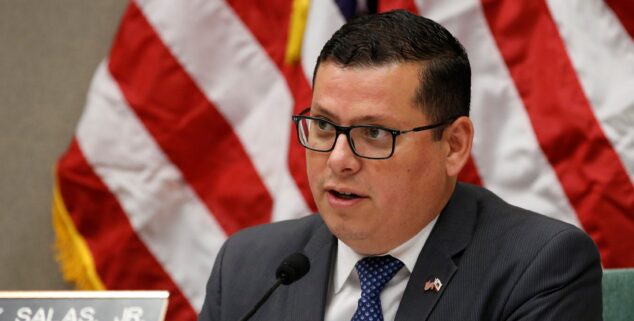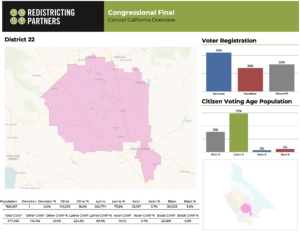CA120
CA 120: Salas would be the first Latino Congressman from the Central Valley
 Rudy Salas, photo by AP
Rudy Salas, photo by APAccording to recent USC polling, and the election buzz among national prognosticators, voters could be on the verge of electing the first Latino in the House of Representatives from the state’s Central Valley.
Yes, you read that right.
If elected, Democrat Rudy Salas would be the very first Latino member of Congress from the heavily Latino Central Valley.
Of the nearly 30 Latinos elected to congress from California, none have resided in the state’s mid-section, stretching from Kern County, up the 5 and 99, through breadbasket communities of Bakersfield, Fresno, Merced, Modesto and Stockton, into Sacramento County.
 You may be thinking about Salas’ opponent, Republican Congressman David Valadao, or long-time Democratic Congressman Jim Costa, or first-Term Republican Congressman John Duarte or even current Truth Social CEO and former Republican Congressman Devin Nunes, but they’re all Portuguese. Potentially, having Latino-sounding surnames has allowed them to have a greater connection to that community, but they aren’t Latino.
You may be thinking about Salas’ opponent, Republican Congressman David Valadao, or long-time Democratic Congressman Jim Costa, or first-Term Republican Congressman John Duarte or even current Truth Social CEO and former Republican Congressman Devin Nunes, but they’re all Portuguese. Potentially, having Latino-sounding surnames has allowed them to have a greater connection to that community, but they aren’t Latino.
When the State Redistricting Commission drew maps in the Central Valley, this idea of allowing Latino voters to elect a candidate of choice – potentially the region’s first Latino elected from the area, was a key concern. Driving much of this was mapping and demographic consultants from groups like the Delores Huerta Foundation and the Mexican American Legal Defense and Education Fund (MALDEF). They peppered the commission with maps and data and constant calls and emails urging stronger Latino density in these seats – enough not just to create Majority Minority seats, but also sufficient numbers to make them effective in electing a candidate of choice from the Latino community.
To make for stronger Latino seats, then-House Speaker Kevin McCarthy’s district was drawn to include the most non-Latino portions of Eastern Kern County, including the continuation of hook around the city of Bakersfield, avoiding the most Latino communities, and an arm doubling back through Tulare County capturing white conservatives. All this prompted a series of Democratic commission observers tweeting flexed arm emojis and Republicans crying foul. (Interestingly, McCarthy’s closest supporters backed off complaints when they got the message that he was happy to have the most Republican seat in the state.)
What was left in CA 22 was a district that, at the time was a whopping 59% Latino Citizen Voting Age Population (CVAP), and with a Democratic registration advantage of 17-points.
The two polls tracked by 538 showed Salas with an average of a 6.5% lead in July/August of that year, making it one of the best pickup opportunities in the state for Democrats.
Despite his apparent demographic and partisan advantages, and strong polling, Rudy Salas lost the election against David Valadao by a three-point margin, 51.5% to 48.5%.
Since 2022, the district has begun to lean a bit more Republican. It is currently at 41% Democratic and 27% Latino – a three-point closing of the gap since redistricting and the 2022 election. The registered population has increased from 59% Latino to 61%, but within that we see Latinos themselves getting a tiny bit more conservative, with Republican registration among Latinos rising from 17% when this district was drawn in 2021, to 20% now. During this period 28% of Latino Men registered as Republican, and just 37% registered Democratic. Latino Republicans are nowhere near gaining parity with Democrats, but in what is a very competitive district these changes can impact the outcomes of close races.
Despite sagging registration, Democrats should significantly benefit from the heightened voter interest in a presidential contest. The turnout of younger voters in the 2022 gubernatorial election was a paltry 19%, compared to 56% in the 2020 presidential. In the gubernatorial Democratic turnout was only 36% compared to 67% in 2020, and Latino turnout was only 28% in the last election, but was 61% four years ago.
Polling collected by 538 this cycle has been mixed. An Emmerson poll showed the district as being tied, the study by USC showed a Salas lead, but well within the margin of error in a relatively small sample, a Democratic sponsored poll showed a 2-point lead for Salas, and Change Research, a pollster with questionable non-voter file methodology, showed Valadao holding a strong 6-point lead. With polls being off in this district, and the fact that this district is one of the hardest in the state to poll, all of these results should be taken with a grain of salt.
Other than losing in 2018, Valadao has shown an incredible ability to win in a district that has a strong Democratic partisan advantage. His victory in 2022 by three points in a district where he had a 17-point disadvantage was a net 20-point partisan differential, greater than any other congressional district in the country. And Valadao has throughout his career been able to win in districts where he had partisan disadvantages or was facing Latino opponents in heavily Latino districts.
Both candidates seem to be trying to reach for the middle in this competitive district. Salas has characterized himself as a “Valleycrat” who bucks his Democratic party, even citing his lone vote against the state’s gas tax as a sign of how he is willing to show independence. Valadao is one of just two Republicans who voted for the Trump impeachment who has managed to survive re-election and while he had previously co-authored a complete national abortion ban, he later said he supported exceptions for rape and incest and in a recent debate against Salas said he would not support a national ban.
Going into the last few weeks of the election, the prospects for each candidate are likely tied to how the presidential contest breaks. If Harris wins nationally, and particularly if she does so by improving her standing with independents and Latinos, and increases the youth vote, then we should expect to see a Salas victory. However, if Trump wins, then this race should shift in the favor of Valadao.
And, in either case, this district is not going to be a one-and-done. This seat in its slightly different pre-redistricting construction produced a switch in 2018 when Democrat TJ Cox won the seat, and flipped back in 2020 when Valadao returned. If Democrats were to pick this seat riding Harris’ coattails, it may be incredibly hard for Salas to hold it in a 2026 midterm with a Democratic administration in Washington DC. Similarly, if Trump wins, and carries Valadao with him, the 2026 election would likely be a big blue wave like 2018, giving Salas or another candidate a significant electoral advantage.
This is a district we are likely to be watching for the rest of the decade or longer.
Want to see more stories like this? Sign up for The Roundup, the free daily newsletter about California politics from the editors of Capitol Weekly. Stay up to date on the news you need to know.
Sign up below, then look for a confirmation email in your inbox.


Leave a Reply